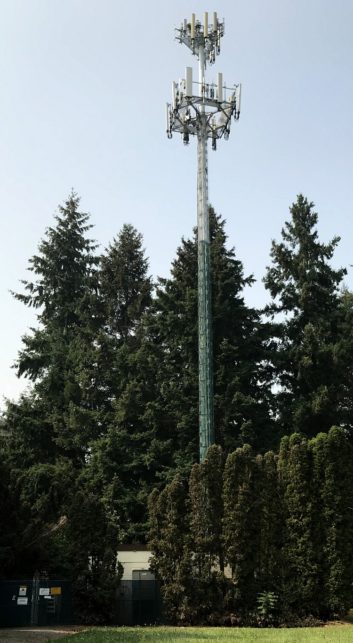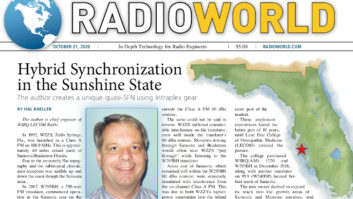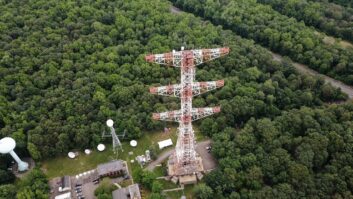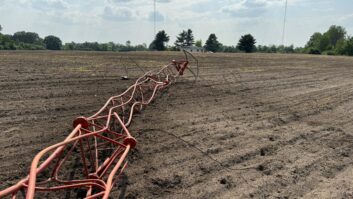Much of AM radio has been in dire straits for some time. It has seen profits decline when faced with new competition from streaming broadcasters and better-quality FM signals.
At the same time, many stations are losing their long-established transmitter sites and being forced to relocate. For them, the options usually don’t include finding another high-quality site, but instead locating a space where they can put a minimal signal into their city of license.
It’s no wonder that the number of licensed AM stations is declining. Over the past decade, their numbers have decreased by 224 — to 4,680 as of September 2020 — while both commercial and NCE FM totals have increased, according to FCC data.
The driving force behind many AM relocations is the rising cost of real estate in what was once farmland or a swamp in the middle of nowhere. Environmental restrictions involving aesthetics, radiofrequency exposure and local zoning restrictions can also be contributing factors.
For some stations, co-locating with other AM broadcasters on a common tower and connecting via a diplexer or triplexer can work, provided the common location will provide adequate service.
Another option is “Co-locating AM Transmitter Facilities With Cellular Monopole Towers,” which is the title of a paper by James A. Dalke of Dalke Broadcast Services, Inc. in Bellevue, Wash., and Stephen S. Lockwood, P.E., of Hatfield & Dawson Consulting Engineers in Seattle.
It was to be presented at the spring NAB Show this year before world events intervened.
Difficult Relocation
The plight of many AM broadcasters is typified by KARR, 1460 kHz, licensed to Kirkland, Wash.

On Feb. 28, 2014, after nearly 50 years of broadcasting, KARR went dark and seemed to have little prospect of returning to the air.
The station had begun broadcasting in 1965 as a 5 kW daytimer with a three-tower array in the rural residential Rose Hill area of Kirkland, Wash., across Lake Washington, east of Seattle. When it was built, Kirkland’s population was about 10,000 and the six-acre transmitter site was on farmland.
In the 40-plus years since, the area has developed into a dense residential area, with the transmitter site one of the only significant areas zoned for residential development but not developed. The population of Kirkland is now 85,000. The property had become far more valuable for residential use.
Because of the residential development, relocating the transmitter site became increasingly problematic. The Class B license requires co-channel protection for KUTI, a 5 kW Class B in Yakima, Washington, a hundred miles southwest of KARR, and adjacent channel 1 kW Class C stations KONP, Port Angeles, 70 miles northwest, and KSUH, Puyallup, 34 miles south.
Protection required for these stations required a traditional array of least three towers on six plus acres of suitable land. In order for KARR to return to the air, a more non-traditional solution needed to be explored. Fortunately, there was help available from the FCC.
In the commission’s ongoing “AM revitalization” effort, three rules in particular affected the KARR relocation.
The FCC relaxed the minimum daytime Community of License (COL) coverage standard from 80 percent to 50 percent of the COL, and for nighttime operations, eliminated the coverage standard for existing AM stations, and reduced the standard to 50 percent for new stations.
The FCC found that these changes would make it easier for stations to cover a community that has expanded beyond the reach of existing facilities, as well as relocate antenna facilities to improve coverage.
Second, the FCC eliminated the “ratchet rule,” which required AM stations to reduce their signal strength when they make facility changes to modify their signal. They found that the rule has not achieved its intended goal of reducing interference.
The commission has generally granted waivers when a station was forced to relocate because of circumstances out of its control, such as the loss of transmitter site lease; the recent rule change simplified the relocation application.
Third, the rules allow authorized AM owners to acquire and move an FM translator up to 250 miles from the AM station’s location to rebroadcast the AM station programming.
While the new rules have enabled an FM translator to rebroadcast KARR, it does not provide any advantage in relocating the AM transmitter facilities. The AM broadcaster with an associated translator must still maintain the licensed AM broadcasting facility.
Slant and Shunt
Cellular monopole towers with a slant or shunt feed have been a solution for AM broadcasters facing the same challenges as KARR, and the slant wire method has been the subject of several research papers.
Ten years ago Ben Dawson of Hatfield & Dawson Engineers in Seattle authored a paper titled: “The Slant Wire Shunt Fed Monopole: A Neglected but Invaluable Technique.” It is available on the Hatfield & Dawson website at https://tinyurl.com/rwee-slant.
In this paper, he concluded that the slant wire feeds are simpler electrically than other ways of feeding grounded based structures. The slant wire technique also imposes far less structural load and is less susceptible to weather related damage in hostile climate conditions.
Dawson also concluded that the shunt fed monopole provides convenient impedance matching, good bandwidth, and efficient radiation patterns.
A viable ground system is also a key component of AM antenna systems.
For many years, it has been apparent that the standard ground system for AM radio using 120 quarter-wavelength ground wires was excessive to providing an effective ground system. This was covered in a paper by Dawson & Lockwood. Using NEC-4 it was possible to model ground system with each individual ground wire.
The FCC has allowed a simplified model for a ground system using an equal area model, which uses a circular model that has an area that is equal to the irregular area of the property. This is useful if the tower is offset from the center of the land or there are other obstructions that require use of a shortened ground system. Where a more detailed simulation is desired, the location of each ground wire can be calculated and the antenna system can be modeled to learn the effects of the compromised ground.
As part of the AM revitalization proceeding, the antenna efficiency requirements have been reduced. These changes have enabled more options for using electrically short antennas and sites that have less area to provide a standard ground system.
Many of the techniques used in colocations of other radio facilities with AM stations have been standard processes, and there are many techniques used to accomplish this. These changes, along with the change in FCC policy to allow slant wire feeding of an AM antenna, allows for use of a tower without a base insulator or a skirt wire arrangement.
Slant wire feed systems were somewhat common before 1960. After that, FCC policy did not allow use of this feed system because it was assumed that there was some asymmetry of the field produced from a slant wire shut fed tower.
These policy changes have greatly expanded the options for dislocated AM stations. While these facilities are a compromise from an ideal facility, they remain a viable option to continue to provide service, and may be the only feasible option for some licensees.
Back on the Air
Utilizing the slant wire feed and improved ground system modeling, Jim Dalke, the current owner of KARR, along with Stephen Lockwood of Hatfield & Dawson, obtained the construction permit to install the Hatfield & Dawson-designed slant wire fed cellular monopole.
Unfortunately, the COVID crisis hit before construction was complete. Installation will continue as soon as restrictions are lifted. The station is licensed to operate with 740 watts daytime, and provides good coverage for the Kirkland area.
In order to obtain approval from the commission, the engineering application had to demonstrate that the facility meets the FCC requirements for a non-directional antenna.
This is best done by using NEC-4 to model the ground system to calculate the efficiency and radiation pattern above the horizon. All AM antennas have radiation patterns that produce fields that are directed above the horizon. The antenna system must also comply with the f(θ) curves provided in the familiar Fig. 8 of FCC rules (47 CFR § 73.160 and 73.190).
This also will model the effects (if any) of the slant wire feed system on pattern circularity. As pattern circularity was better defined in moment method rule making process and the use of moment method for re-radiation analysis from other communication towers, this is defined at ± 2 dB.
The tower can be modeled to include the cellular antenna platforms and other changes from a uniform cross section guyed tower. This helps to account for any additional “top-loading” that these fixtures provide. There could be situations where the sectionalized tower and top-loading flags used in the FCC database to describe unusual antenna might be employed. This was not the case for KARR, as the modeled radiation pattern was enclosed within the f(θ) curves for a tower height of 80.2°. The modeled elevation pattern in several pertinent azimuths is compared to the standard pattern and f(θ) curves to assure that it does not exceed these limits.
The H&D drawing shows how the shunt feed is connected between the transmitter and the 150-foot monopole antenna (see Fig. 2 at bottom). The cellular antenna array at the top actually provides some “top loading.”
While the AM coverage from the new site will be significantly less than the original site abandoned in 2011, KARR has an FM translator associated with the AM license under the FCC’s revitalization rules.






